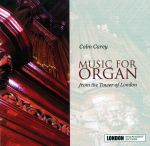 LONDON LIR 004
LONDON LIR 004
70' 11"
It is a real pleasure to welcome this new recording. I have written enthusiastically about the Ltourneau organ in the chapel of St Peter ad Vincula in the Tower of London in previous issues but this is the first opportunity most readers will have had to hear it for themselves.
Most of the items recorded here were heard during the recent recital series and reflect Colm Carey's own interests as well as works which particularly suit the instrument. The opening could hardly be more ur-typically English - SS Wesley's Choral Song and Fugue, in the expanded version to include the pedals by Walter Emery, which Colm Carey uses to demonstrate the English liturgical side of the instrument; fine, warm choruses matched to noble, yet unstrident reeds.
Given the close connection of the Chapel with Henry VIII it is good to find a set of Renaissance Dances in Colm Carey's own arrangement. You could easily believe you are listening to a totally different instrument after the romantic warmth of the Wesley. Pastime with good company is pleasantly familiar, but I particularly enjoyed the more restrained melancholy of If love now reigned and the high-lying Hlas Madame. Giles Farnaby's brief Tower Hill is delightful and runs smoothly into My Lady Carey's Dompe.
Moving away from British music, CPE Bach's Sonata in D allows us to hear the more Germanic side of this organ with some fine and bright solo stops and rapidly flowing articulation. The only work by J S Bach included is a smoothly seductive reading of the Partita Sei gegrsset, Jesu gtig. I find Colm Carey's Bach performances so convincing I hope that we will eventually get a complete works from him - recording companies take note!!
Returning to Britain, I am glad that Andrew Johnstone's arrangement of Irish Airs and Dances has been included as this was very well received in recital. If it has a sentimental edge there is nothing amiss with that given the more restrained company surrounding it. The rapid dance rhythms give Colm Carey a chance to exhibit his manual dexterity and the splendid action of the instrument itself. As a recital piece it is one which will surely be taken up by other organists looking for new works with obvious audience appeal.
Vaughan Williams' Prelude on Rhosymedre allows us a moment or two of quiet introspection before the final item - Francis Jackson's Toccata, Chorale and Fugue which fires on all cylinders. Again we seem to be hearing a different and much larger instrument, such is the versatility of the Ltourneau.
The accompanying booklet gives ample notes and specification though no individual registrations which would have been useful given that this is the first recording of the organ. However, this is a splendid recording which should sell well. Let us hope it encourages the powers that be at the Tower to promote greater access to this most musical of instruments. It would be a real shame if it became yet another hidden gem for lack of public exposure. Sunday services are fine but there is a world beyond! BH
